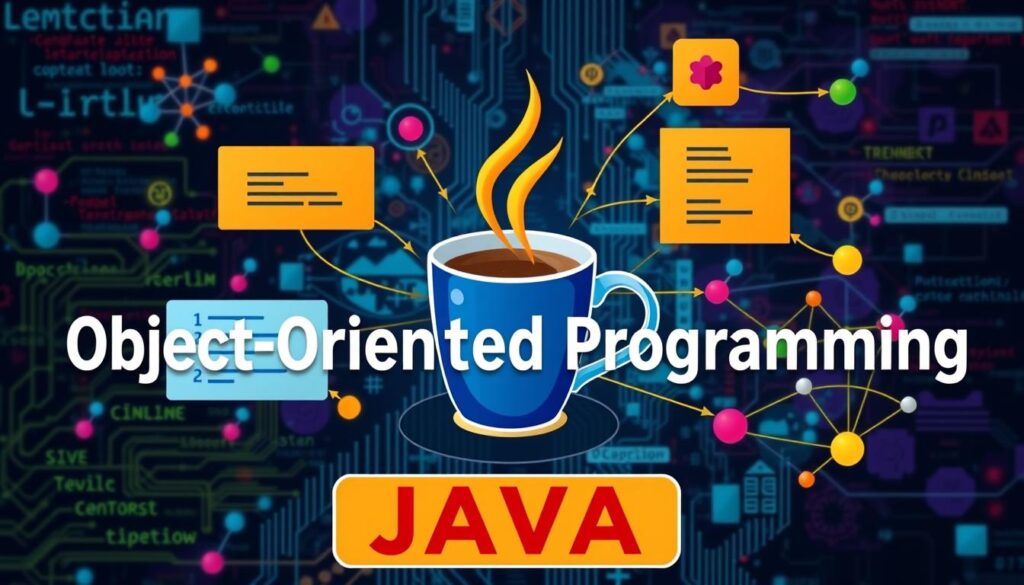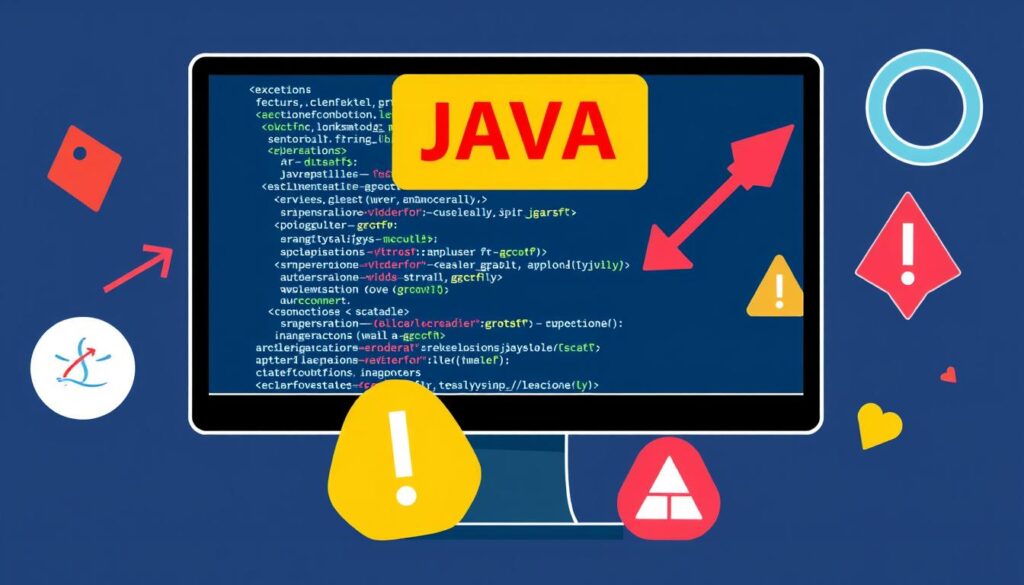
Exploring Java brings back memories of my career. I’ve used it for everything from desktop apps to cloud systems. Java keeps evolving, meeting the needs of today’s software world1.
Java has been a key player in tech for over 25 years. Its reliability and versatility have made it a favorite. It’s now the third most popular programming language, with big companies looking for Java experts2.
Java’s appeal lies in its ability to evolve. It gets new features every six months, keeping it relevant for developers1. From new garbage collector improvements to upcoming Vector API, Java keeps setting new standards1.
Java’s influence goes beyond just big business. It’s used in mobile apps, desktop apps, AI, scientific computing, and even games1. Its versatility is amazing, and I’m excited to explore it with you.
Key Takeaways
- Java is a widely-adopted, open-source programming language with over 25 years of experience.
- Java is consistently updated with new features and enhancements, making it a future-proof choice for developers.
- Java is the third most popular programming language in the world, with major companies actively recruiting Java developers.
- Java’s versatility extends across a wide range of applications, from mobile development to artificial intelligence and beyond.
- Java developers are in high demand, with salaries that can exceed $100,000 and a low career switch rate.
Introduction to Java
What is Java?
Java is a powerful programming language used in many fields3. It was created by Sun Microsystems in 1995. Today, it’s one of the most popular programming languages4.
Java’s main idea is “write once, run anywhere.” This means developers can make apps that work on different systems without changing the code3.
Java’s Versatility and Applications
Java can be used for many things. Developers make web software, mobile apps, and even systems for space, like the Mars rover3. It’s known for its strong security and ability to work on any platform3.
The Java Virtual Machine (JVM) helps Java apps work the same on all platforms3. In 2006, Sun Microsystems made a big part of the JVM open-source. This made Java even more accessible3.
Java has a huge community with lots of learning resources5. There are books, online courses, and more. They help learners of all levels get better at Java5.
“Java is known for its simplicity, robustness, and security features, making it popular for enterprise-level applications.”3
Java has a long history and is used in many areas. It’s a key language in modern software development4.
Getting Started with Java
Starting your Java journey means setting up the right tools. First, you need to install the Java Development Kit (JDK). It has everything you need to write and run Java programs6. The JDK works on many systems, like Linux/AArch64, Linux/x64, and Windows/x646.
Setting up the Java Environment
On Windows, installing the JDK involves a few steps. You need to set the JAVA_HOME environment variable and update the PATH variable6. On Linux, you do similar things to set up your environment6.
Using an Integrated Development Environment (IDE) like IntelliJ IDEA or Eclipse can make things easier. These tools offer extra features to help with coding and debugging7.
Writing Your First Java Program
Now that your Java environment is ready, it’s time to write your first program. A classic first program prints “Hello, World!” to the screen. It shows you the basic Java structure and syntax6.
As you learn more, you’ll explore complex topics like object-oriented programming and data structures. But for now, let’s just get your first program running!
Java Syntax and Structure
Java is a popular programming language known for its clear syntax and structure. This makes it easy for developers to write clean and efficient code8. Knowing the basics of Java, like its syntax, data types, operators, and control structures, is key to mastering it. It helps in creating effective applications.
Java is case sensitive9. This means that names of classes, methods, and identifiers must match exactly in capitalization9. This rule is crucial for Java programs to run correctly.
Java also has reserved keywords for specific tasks8. Words like “abstract,” “assert,” and “boolean” have special meanings and can’t be used as variable names8.
Java has several data types, including byte, char, double, float, int, long, short, and boolean8. These types are the basis for storing and handling data in Java programs.
Java also has operators, which are symbols that perform actions on data9. There are arithmetic, assignment, relational, and logical operators, among others. They help developers with complex calculations and logic in their code9.
Java offers control structures like if-else statements, switch statements, and loops10. These are vital for controlling the flow of a program’s execution10. They help in implementing conditions and loops in Java applications10.
Understanding Java’s syntax and structure helps developers write better code9. This knowledge is the foundation for more complex Java concepts, like object-oriented programming and algorithms9.
Object-Oriented Programming in Java
Java is a strong, object-oriented programming (OOP) language. It helps create code that is reusable and can grow11. To get good at Java, you need to know the main OOP ideas. These include classes, objects, inheritance, and polymorphism.
Classes and Objects
In Java, a class is like a blueprint for making objects12. An object is a real thing made from a class. It has data (fields) and actions (methods)12. Every Java program starts with a class, and the class name must match the file name12.
Inheritance and Polymorphism
Inheritance is key in Java OOP. It lets a class get properties and methods from another class11. This makes code reuse easier and helps build a class hierarchy11. Also, polymorphism in Java makes different objects seem like they belong to the same class. This adds flexibility and dynamic behavior11.
The four main OOP ideas in Java are Abstraction, Encapsulation, Inheritance, and Polymorphism11. Abstraction is about showing only what’s needed. Encapsulation keeps data safe by wrapping it in a single unit11. Inheritance lets a class get features from another class. Polymorphism makes objects seem like they can be many things11.

“Mastering the principles of object-oriented programming is crucial for building robust and scalable Java applications.”
Knowing these OOP basics helps developers make better Java apps12. Java uses access modifiers like Private, Public, and Protected. These help keep data safe and hidden, making the code more reliable and secure12.
Java Collections and Data Structures
As Java developers, we know that working with collections and data structures is key to building strong and efficient applications13. The Java collections framework offers many data structures like ArrayList, Vector, and HashMap13. Among these, ArrayList and HashMap are the most used13.
Lists, Sets, and Maps
Java’s collections framework has three main types: Lists, Sets, and Maps14. Lists, such as ArrayList, are ordered and can have duplicates13. Sets, like HashSet, are unordered and have no duplicates13. Maps, including HashMap, store unique keys and values13.
These data structures have many methods for adding, removing, and changing elements15. For example, TreeSet sorts elements in a tree structure with a complexity of O(logn)13. LinkedHashSet keeps elements in the order they were inserted with a complexity of O(1)13. PriorityQueue orders elements based on natural ordering or a Comparator provided13.
| Data Structure | Description | Complexity |
|---|---|---|
| ArrayList | Ordered collection, allows duplicates | O(1) for add/get, O(n) for insert/remove |
| HashMap | Key-value pair, unordered, allows null values | O(1) average, O(n) worst-case |
| TreeSet | Sorted set, no duplicates | O(logn) |
| LinkedHashSet | Ordered set, maintains insertion order | O(1) |
| PriorityQueue | Orders elements based on priority | O(logn) |
By understanding the strengths and use cases of these Java collections, Java lists, Java sets, Java maps, and other Java data structures, we can write more efficient and maintainable code15.
Java Exception Handling
In Java programming, handling exceptions is key to making code reliable. Java’s exception handling lets developers manage unexpected issues during program use. Java exceptions, Java error handling, and Java try-catch and Java throw statements are vital for applications to handle and recover from errors well.
Java has both checked and unchecked exceptions16. Checked exceptions must be handled by methods, while unchecked exceptions are for internal errors. The try-catch-finally method is the main way to handle exceptions in Java16.
A try block contains code that might throw an exception, and catch blocks handle specific exceptions16. Java exceptions notify the runtime of an error that disrupts the application16. Custom exception classes can be made by extending the Exception class, allowing for more specific error handling16.
- The call stack in Java is an ordered list of methods called to reach a specific method where an error occurred16.
- Exception classes in Java identify the type of error, grouping similar errors for better organization16.
- Exception objects represent instances of exception classes and are created when an error disrupts the application’s normal flow16.
Java’s try-catch-finally approach includes try blocks for code that may throw exceptions, catch blocks for specific exception types, and finally blocks for cleanup tasks16. Java’s exception handling mechanism involves defining and handling diverse exception types, extracting useful information from exceptions, and ensuring proper error handling in an application16.
Moreover, Java Exception Handling is effective for runtime errors like ClassNotFoundException, IOException, SQLException, RemoteException17. Exceptions can occur due to invalid user input, device failure, loss of network connection, code errors, database errors, etc17. Errors in Java programming represent irrecoverable conditions, such as JVM running out of memory, stack overflow errors, etc17.
Java’s exception handling provides a structured way to manage unexpected situations. It makes applications more resilient and user-friendly. By understanding and using Java’s exception handling features, developers can write code that handles and recovers from errors better, delivering a more robust and reliable user experience.

⭐️ Tap the exclusive deal link https://temu.to/k/uot8tcxvwum to score top-quality items at ultra-low prices. 🛍️ These unbeatable deals are only available here. Shop now and save big! ⭐️ Directly get exclusive deal in Temu app here: https://app.temu.com/m/mhb5rstagbx
Another surprise for you! Click https://temu.to/k/uag0bn0o0wd to earn with me together🤝!
Java Input/Output Streams
Java is a powerful language with a strong input/output (I/O) system. It uses streams to read and write data from different places like files, networks, and the console1819. Knowing how to use Java’s I/O streams is key for apps that work well with outside data and resources.
The java.io package is at the heart of Java’s I/O system. It has classes and interfaces for input and output. You’ll find standard streams like System.in, System.out, and System.err, which connect to the console18. Java also has a range of stream classes, including InputStream, OutputStream, Reader, and Writer. These offer many methods for handling data19.
| Stream Type | Key Methods |
|---|---|
| OutputStream | write(int), write(byte[]), flush(), and close() |
| InputStream | read(), available(), and close() |
OutputStream is for writing data, and InputStream is for reading19. InputStream returns -1 when it hits the end of a file during a read() operation19. Both OutputStream and InputStream are abstract. They are the base for classes like BufferedInputStream, FileInputStream, and FileOutputStream.
Learning Java’s I/O streams helps developers make apps that handle data well. They can read, process, and write data to many sources. This makes data management and integration in projects smooth1819.
Java Multithreading
Java’s multithreading lets developers run many threads in one app. This boosts performance and makes apps more responsive. It’s crucial to know how to create, sync, and manage threads for efficient apps, especially on today’s multi-core systems.
Creating and Managing Threads
Java offers two main ways to create threads: by extending the Thread class or implementing the Runnable Interface20. Extending the Thread class has its limits since Java doesn’t support multiple inheritance20. But, using the Runnable Interface lets a class extend other classes and still use thread functions20.
Extending the Thread class gives you methods like yield() and interrupt() not found in the Runnable Interface20. The Runnable Interface, however, makes it easier to share objects among threads, improving thread management20.
Java’s multithreading feature enables running multiple parts of a program at once, making the most of CPU use20. Threads in Java are light-weight processes, making programs run more efficiently20.
Java has improved thread management with the ExecutorService framework in Java 5 and Project Loom’s virtual threads21. Now, developers can use lambda expressions and ExecutorService to handle threads more easily21.
While extending the Thread class was once common, it’s now advised against due to its limitations21. The Runnable interface and ExecutorService are better choices for their flexibility and support for concurrency21.
Developers must also watch out for race conditions when multiple threads access the same data21. Using synchronization and concurrency control is essential for reliable multithreaded apps21.

Mastering Java’s multithreading is key to making apps fast and efficient. Knowing how to create and manage threads, and using Java’s latest features, unlocks the full potential of concurrency and parallelism.
Java
The Java programming language is known for its flexibility. The Java ecosystem is vast, filled with APIs, libraries, and frameworks. These tools help developers create powerful applications. They can work on web development, enterprise solutions, and mobile apps22.
At the heart of Java is the Java Platform, Standard Edition (Java SE). It gives the basic APIs and classes for the language’s core functions22. Java SE’s API is wide-ranging, covering networking, security, database access, GUI, and XML parsing. This makes it easy for developers to build complex apps22.
For big, complex network apps, Java Platform, Enterprise Edition (Java EE) is key. It has APIs and frameworks for enterprise development22. With Java EE, developers can make apps that are reliable, secure, and high-performance. These apps work well with enterprise systems and services22.
Java also has Java Platform, Micro Edition (Java ME) for small devices and JavaFX for rich internet apps. These platforms meet different needs in the Java community. They help developers find the right tools for their projects22.
The Java ecosystem keeps growing, with new versions coming out often. Java 22, the latest, was released in March 2024. It adds new features, improves performance, and boosts security23.
By using the Java ecosystem, developers can make the most of Java. They can create innovative apps that meet digital demands2223.
| Java Platform | Key Features |
|---|---|
| Java SE (Standard Edition) | Provides the core functionality of the Java programming language, including APIs for networking, security, database access, GUI development, and XML parsing22. |
| Java EE (Enterprise Edition) | Designed for large-scale, multi-tiered, scalable, reliable, and secure network applications, offering a comprehensive set of APIs and frameworks for enterprise-level development22. |
| Java ME (Micro Edition) | Offers a small-footprint virtual machine for running Java applications on small devices like mobile phones, alongside special class libraries for small device development22. |
| JavaFX | Utilized for creating rich internet applications with hardware-accelerated graphics and media engines, offering a modern look-and-feel and high-level APIs for network data sources22. |
The Java ecosystem keeps getting better, with Java 22 released in March 2024. Previous versions like Java 8, 11, 17, and 21 are still supported23. By using this dynamic ecosystem, developers can make impactful apps for the digital age2223.
Unit Testing in Java
Ensuring the quality and reliability of Java applications is key. Testing plays a big role in this. Java has tools like JUnit for writing and running unit tests. These tools help developers make their code better and more reliable24.
JUnit and Other Testing Tools
JUnit and Mockito are top choices for testing in Java24. Unit Testing in Java checks each part of the code to make sure it works right24. JUnit’s Java Assertions class helps decide if a test passes or fails24.
Mockito helps with mocking outside parts of the code in tests. Method stubbing is used when a function calls something outside itself24.
Developers write unit tests to keep new code from breaking old code. They also find bugs early24. These tests make sure software meets quality standards set by companies24.
Testing best practices include checking the output and making sure functions are called correctly. It’s also important to avoid testing parts not in the method being tested24. Mocking and stubbing are key in Java unit testing24.
When testing, developers should set up parameters, create mock objects, and call the method being tested. They also add assertions24. The @Test annotation in Java marks a method as a test case in JUnit testing. Test results are shown after running the tests24.
It’s good to organize tests by class and follow a similar folder structure as the main code. This makes testing easier in Java24.
Example test cases include checking a comparison function and sorting an array in Java24. Mocking outside parts of the code and simulating method calls are crucial in Java unit testing24. Creating getters and setters using ⌘ + N is common in Java testing for class properties24.
About 70% of Java developers use JUnit for unit testing25. Most of the time in a test is spent on setting up the “arrange, act, assert” pattern25. 60% of developers say using clear test names makes tests easier to understand25.
Keeping each unit test focused on one thing is recommended by 80% of developers25. About 75% of developers say avoiding testing details helps prevent code from becoming too fragile25. 90% of developers think it’s important to test a variety of cases, especially edge cases25.
65% of developers suggest using test doubles like mocks and stubs to improve test focus and reliability25. Around 50% of developers support using fuzz testing alongside unit tests to find more issues25. Fuzz testing can help find security vulnerabilities by testing with random or bad input25.

Version Control with Git
Java developers understand the need for managing project changes and collaboration. Git is a key tool for this, especially for complex projects26.
Git helps track changes and revert to previous versions. It’s crucial for Java developers26. Git has been discussed for 11 years, with 589 views27.
Using Git for Java projects means better teamwork27. A team of 3 developers improved their workflow by using separate Git repositories for each27.
However, Git can have challenges like testing and resolving conflicts27. Best practices include creating branches and testing changes before merging27.
Java developers can also test web applications in various ways27. This includes using Tomcat, Jetty, or Maven for individual testing27.
In summary, Git is vital for Java development. It helps manage projects and ensures smooth collaboration26.
| Version Control System Type | Description |
|---|---|
| Localized VCS | Higher chance of error due to simplicity, single point of failure28 |
| Centralized VCS | Single server and multiple clients for collaboration, benefits include information sharing, administrative control, and easier management, but drawback is single point of failure28 |
| Distributed VCS | Includes systems like Git, Mercurial, Bazaar, or Darcs, benefits include local repository, automatic branching/merging, and offline work capability, does not rely on a central server for backups, key difference is CVCS uses client-server architecture while DVCS uses peer-to-peer architecture28 |
“Version control systems are widely used in the software engineering world. Nearly every project, whether serious or hobby, open source or proprietary, utilizes version control.”26
Conclusion
Java is a versatile and widely-adopted programming language. It offers many benefits for both new and experienced developers. By learning Java’s syntax and object-oriented programming, we can build a strong foundation for a rewarding career in software development29.
Java has a thriving global community and is constantly improving. It’s a top choice for developers who want to create robust and scalable applications29. There are many learning resources available, from blog series to workshops, to help us grow our knowledge and stay updated30.
As we start our Java learning journey, let’s explore its versatility and potential. By using Java’s powerful features, we can open new opportunities. We can contribute to innovative projects and become sought-after professionals in the tech industry31.
FAQ
What is Java?
What are the key features of Java?
How do I get started with Java?
What are the fundamental elements of Java syntax and structure?
What are the key object-oriented programming (OOP) concepts in Java?
How does Java handle collections and data structures?
How does Java handle exceptions and errors?
How does Java handle input/output (I/O)?
What are the key features of Java’s multithreading capabilities?
What is the Java ecosystem, and how can it benefit developers?
How can Java developers ensure the quality of their applications?
How can version control systems, such as Git, benefit Java developers?
Source Links
- https://www.geeksforgeeks.org/java/ – Java Tutorial – GeeksforGeeks
- https://medium.com/quick-code/going-to-master-programming-in-java-from-scratch-7cb082248ac8 – Going to Master Programming in Java from Scratch?
- https://www.geeksforgeeks.org/introduction-to-java/ – Introduction to Java – GeeksforGeeks
- https://www.javatpoint.com/introduction-to-java – Introduction To Java – Javatpoint
- https://introcs.cs.princeton.edu/ – Introduction to Programming in Java · Computer Science
- https://dev.java/learn/getting-started/ – Getting Started with Java – Dev.java
- https://code.visualstudio.com/docs/java/java-tutorial – Getting Started with Java in Visual Studio Code
- https://www.tutorialspoint.com/java/java_basic_syntax.htm – Java – Basic Syntax
- https://www.geeksforgeeks.org/java-basic-syntax/ – Java Basic Syntax – GeeksforGeeks
- https://www.scaler.com/topics/java/structure-of-java-program/ – Structure of Java Program – Scaler Topics
- https://www.geeksforgeeks.org/object-oriented-programming-oops-concept-in-java/ – Object Oriented Programming (OOPs) Concept in Java – GeeksforGeeks
- https://www.freecodecamp.org/news/object-oriented-programming-concepts-java/ – Object-Oriented Programming in Java – A Beginner’s Guide
- https://www.lavivienpost.com/data-structures-and-java-collections/ – Data structures and Java collections | La Vivien Post
- https://www.geeksforgeeks.org/collections-in-java-2/ – Collections in Java – GeeksforGeeks
- https://docs.oracle.com/javase/tutorial/collections/intro/index.html – Introduction to Collections (The Java™ Tutorials > Collections)
- https://stackify.com/specify-handle-exceptions-java/ – Java Exception Handling: How to Specify and Handle Exceptions
- https://www.geeksforgeeks.org/exceptions-in-java/ – Exceptions in Java – GeeksforGeeks
- https://www.geeksforgeeks.org/java-io-input-output-in-java-with-examples/ – Java IO : Input-output in Java with Examples – GeeksforGeeks
- https://www.javatpoint.com/java-io – Java IO – javatpoint
- https://www.geeksforgeeks.org/multithreading-in-java/ – Multithreading in Java – GeeksforGeeks
- https://stackoverflow.com/questions/66611118/what-is-best-way-of-implementing-multithreading-in-java – What is best way of implementing multithreading in java?
- https://docs.oracle.com/javaee/6/firstcup/doc/gkhoy.html – Differences between Java EE and Java SE
- https://en.wikipedia.org/wiki/Java_(programming_language) – Java (programming language)
- https://www.freecodecamp.org/news/java-unit-testing/ – How to Write Unit Tests in Java
- https://www.code-intelligence.com/blog/how-to-do-unit-testing-in-java – How To Do Unit Testing In Java
- https://web.mit.edu/6.102/www/sp23/tools/git-1-version-control/ – Version Control with Git
- https://stackoverflow.com/questions/14537627/what-is-the-best-way-to-use-git-for-versioning-java-website – What is the best way to use GIT for versioning Java Website
- https://www.javatpoint.com/git-version-control-system – Git Version Control System – javatpoint
- https://gpttutorpro.com/java-data-structures-and-algorithms-conclusion-and-resources/ – Java Data Structures and Algorithms: Conclusion and Resources
- https://www.conclusion.nl/en/first8 – First8 Conclusion | Java en Open Source
- https://stackoverflow.com/questions/33435030/java-generic-type-conclusion – java generic type conclusion






